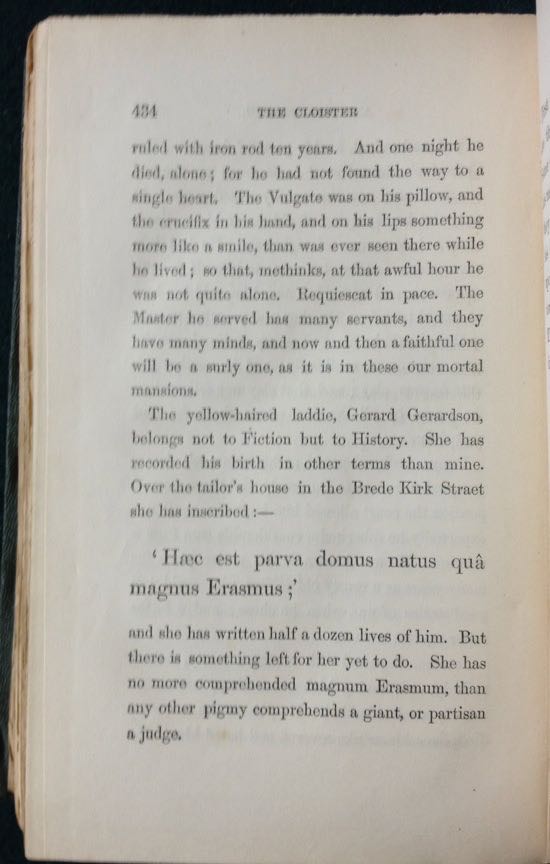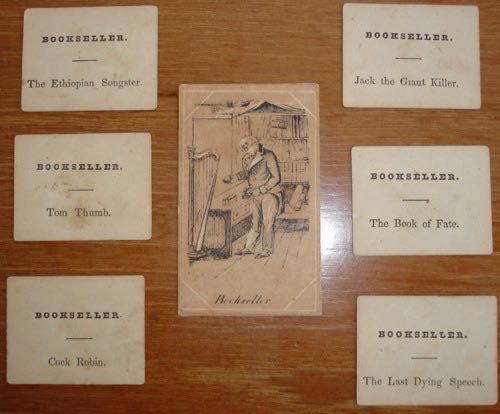
November - December 2011

21 December 2011
That Time of Year : Best Book of 2011

— Reggie Oliver. Mrs Midnight and other stories . With illustrations by the author. Tartarus Press, [2011]. The most compelling and accomplished book that I read this year ( as reviewed here ), with close competition from Lisa Goldstein’s outstanding novel The Uncertain Places and On the Road to Babadag by Andrzej Stasiuk, both of which are reviewed below. The original edition of Mrs Midnight , of four hundred copies, was out of print upon publication ; the publisher has announced a paperback reprint for early 2012.
older books *
— H. Alain-Fournier. Le Grand Meaulnes ,
1913. notice
— Timothy d’Arch Smith. Alembic. A Novel . Dalkey Archive
Press, [1992]. notice
— Charles Reade. The Cloister and the Hearth. A Tale of the Middle
Ages (1861). notice
— Rebecca Solnit. Wanderlust. A History of Walking .
(Viking Penguin, 2000 ; Penguin paperback). Just read it : it’s
great
— Larry Wolff. The Idea of Galicia. History and Fantasy in Habsburg
Political Culture . Stanford University Press, 2010 [but : Edwards
Brothers Inc. | Ann Arbor, MI. USA | March 7 2011]. A remarkable book, fascinating
topic. review below
* This has been a Conrad year of reading, in which I have encountered
some real delights, including Nostromo. A Tale of the Seaboard (1904),
the ancestor of the political thriller ; and the utterly devastating Victory.
An Island Tale (1915).
highlights of 2011 : eleven books
— Lauren Beukes. Zoo City (2010 ; Angry Robot
paperback, 2011). review
— John Clute. Pardon This Intrusion. Fantastika in the World Storm .
Beccon Publications, 2011. brief
notice
— Lisa Goldstein. The Uncertain Places . Tachyon Publications,
2011.The best novel I read this year. review below
— Will Hermes. Love Goes to Buildings on Fire. Five Years in New
York That Changed Music Forever . Faber & Faber, 2011. One upon
a time, when New York City was still a scruffy destination for starry-eyed musicians
from the outer boroughs, New Jersey, or the midwest, everyone really did come
to each other’s gigs. A lovely, information-dense story of the mid-1970s,
with rigorous documentation and unmistakable love of music.
— Robert Irwin. Memoirs of a Dervish. London: Prõle Books,
2011. notice below
— Johan Kugelberg and Will Swofford Cameron, curators. Dreamweapon.
The Art and Life of Angus MacLise 1938-1979 . Boo-Hooray, 2011. notice
— China Miéville. Embassytown . Macmillan, 2011. notice
— Nat Segnit. Pub Walks in Underhill Country . Fig Tree
/ Penguin, 2011. An absolute nutter of a book, great fun. brief
notice
— Andrzej Stasiuk. On the Road to Babadag. Travels in the Other
Europe . Translated from the original Polish by Michael Kandel. Houghton
Mifflin Harcourt, 2011 review & interview with the
translator below
— Mark L. Valentine. The Peacock Escritoire [issued
with:] Shards. Journal Notes [and:] Santiago Caruso. Portfolio .
Bucharest - Orient : Passport Levant, 2011. review
— James Walsh. The Ephemera. [Selections from the Travels (1791)
of William Bartram : a found poem]. Edition of thirty copies printed by
the artist, October 2011. notice below
The Present Imperfect : ‘ from one nowhere to another ’
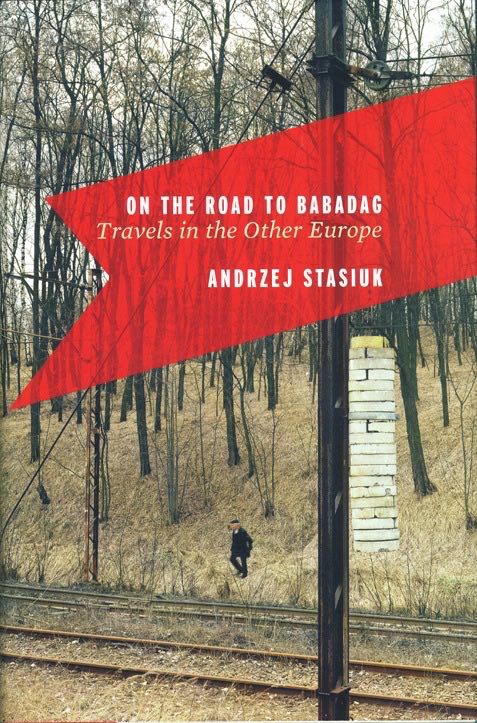
— Andrzej Stasiuk. On the Road to Babadag. Travels in the Other Europe . Translated from the original Polish by Michael Kandel. Map, two photographs. [xiv], 255 pp. Houghton Mifflin Harcourt, 2011.
It has been said that Onomastics is the highest science for the study of names encompasses all human activity. One branch of the study of names might be deemed Erinnerungswissenschaft or the study of memory (the creation of knowledge of interiority). Ephemera and numismatics are part of the documentation of this knowledge. On the Road to Babdag is restless exploration of the other Europe, an extended contemplation of the marginal, survival outside the famed cities of central Europe or the aborted farms that are the suburbs. Stasiuk’s prose sorts through his shoebox of old photographs and declares place and incident and people with intensity. From a flimsy outdated coin, a Hungarian banknote, a parking receipt, or the pub bill from Sfântu Gheorghe, he summons a world of lost nationalisms, folkloric riches, and simple human life. He drinks a Ciuc beer at a ramshackle pub at the uttermost end of the Danube alive with motion, music, gesture : “ It was simply a sign of existence. . . . They had to examine one another and raise a racket. ” In this desolate village Stasuk finds all the vitality leached from the internet-connected suburbs that he avoids.
On the Road to Babadag is a study of time and a chronicle of names not to be found in the atlas. The reader is warned : “ I take the map, interested precisely in its deterioration. It wore out first at the folds. ” . And after a while one understands that the blank spaces on the map are more important than the places it records. “ They lived in the old Jewish quarter, at the edge of a Slovak town, at the foot of a Hungarian castle, so in order to exist and not disappear, they had to create their own rules, their own special theory of relativity, and a gravity that would keep them on the surface of the earth and not let them fall into the interstellar void, into the vaccum of oblivion. ” Stasiuk’s fascination with the Gypsies is one of the compelling tensions of the book : the timelessness and disregard for fixity which he assigns to the migrants function as a counterweight to his obsessive, Baudelairean memory. The section on the Danube delta is fertile and evocative. “The river had emptied into the sea, and the land, with all its events, had come to a halt. There was no returning by the same route. I could feel how time, until now given human aspects, was dissolving to its original form. ” Stasiuk offers a vision of Europe, people living simply and in close proximity to their animals, that is a thorough refusal of globalization : “ the virtual funds of corporations circulating in electronic space, the contens of the multilevel underground coffers on Bahnstrasse in Zurich, all the paper, the ore, the rows of digits coursing through the icy bloodstream of fiber-optic cables, should be thrown out, should lose its value, should be exchanged for zeroes in such loci as Erind, Vicşani, Sfântu Gheorghe, Rozput, Tiszaszalka, Palota, Bajram Curri, Podoliniec, the square in front of the church in Jablonna Lacka, the train station in Vilmány, the trains station in Delatyn at dawn, the grocery store in Livezile, the grocery store in Spišska Belá, the pub in Biertan, the rain in Mediaş, and a thousand others . . . ”.
Where else will you read a passage that begins “ Chişinău, ah Chişinău ! ” or “ I love this Balkan shambles, . . . ” or Stasiuk’s search for Ubl’a, “ that fucked-up international bazaar at which the Moldovans spread out on the ground all the treasures of Transnistria in the hope of exchanging them for the riches of Transcarpathia, the jewels of Szabolcs-Szarmár, the inexhaustible goods of Maramureş ” ? My keyboard does not have enough diacritical marks to keep pace with On the Road to Babdag .
There are some superb list poems in On the Road to Babadag , indeed the entire book is an extended list poem. “ The coins remind me of things and places : the street stalls in Saranda, the lane stanchions on the Slovenian highway A1, the ferries on the Tisa … ”
On the Road to Babadag has been translated with unusual subtlety and poetry. The Endless Bookshelf is pleased to present a short interview with the translator, Michael Kandel, whose translations include numerous works by Stanislaw Lem.
What particular joys and knotty puzzles did the text of On the Road to Babadag present to you as translator ?
Michael Kandel : I liked the author’s approach to the world: the poet outsider looking for truth not in the usual Western packaging. I found some of his poetry and scenes memorable — for example, having to wait in your car for the season to change so the vegetation stops obscuring a road sign. I liked, in general, his honesty (absence of posing). There were many knotty puzzles : slang not found in any dictionary, specific terms for things in factories or on farms (and I'm not exactly at home in either a factory or on a farm), a philosophical diction that can be obscure but cannot be dismissed. Since this work is set in the real world and not in a fantasy, I couldn’t make up stuff. The place-names were murder : a river in Hungary spelled one way, in Slovakia another, et cetera.
Do you see the book as a celebration or as an elegy for a vanishing Europe ? the book was first published in 2004, describing trips of several years before that; in 2011, does anything still remain of the worlds Stasiuk enumerates ?
MK : I see it more as a satire and condemnation of Western Europe. I guess, yes, there’s an elegiac tone and the sense that things are vanishing — but I think Stasiuk’s point is that the West too is vanishing (or is doomed) and that this other, forgotten Europe will outlast it. Note that the despised Gypsies endure. I haven’t traveled in the places Stasiuk describes but guess that there has been no dramatic change between 2004 and 2011.
“ Buster Keaton of the Delta ” and “ blues ” : some very American borrowings in a work that contains some astounding meditations on the consequences of globalization. Is “ blues ” now a standard Polish word ?
MK : I don’t think so. Kerouac is a major influence on Stasiuk, for what that’s worth. It might be helpful to think of Stasiuk as a beat poet. He’s a thorough rebel. (I’d recommend another author who influenced him, Polish : Marek Hlasko. Previous generation.)
Are Stasiuk’s diction and style unusual in contemporary Polish writing ?
MK : I think so. He combines poetic style with
very unpoetic themes and language. The language can be quite profane.
The English doesn’t quite convey that — perhaps because
cursing has a different effect-function-valence in the USA than in
Poland.
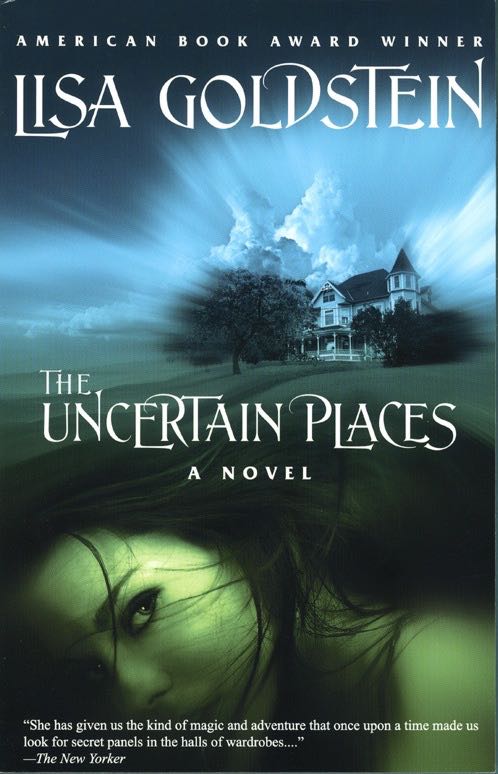
— Lisa Goldstein. The Uncertain Places . Tachyon Publications, 2011.
The Uncertain Places is the story told by Will Taylor, Berkeley student and later psychotherapist, as he becomes part of the unusual Feierabend family in rural Napa county, California. Will is introduced to Livvy, one of the three Feierabend daughters of his generation, by his childhood friend Ben. He learns of the Bargain made with folk of the “ other realm ” hundreds of years before that has ensured the family’s prosperity ; and then begins to experience the true cost of the compact.
“ The boundaries aren’t fixed, you know. They’re more like tides, one flowing into the other. ”
Goldstein’s novel is sophisticated and rich in intricate allusion. The Uncertain Places plainly owes its existence to Little, Big (1981) and the acknowledgments are many and richly transformed. It is no way simply a transplantation, for the novel is equally rooted in a subversive and close critical reading of the fairy tale traditions, in particular the tales of the brothers Grimm. Where Crowley’s novel deploys a vast, knowing, and multigenerational narration of events unfolding against a sense of worsening national malaise, The Uncertain Places is a tale of much narrower compass, told by a psychologist curiously lacking in self-awareness, whose feeling of being distinct from the Feierabend family endures long after his actions and love have made him a central part of it. The possible limitations of this narrative strategy are transcended by vivid scenes (in this world and elsewhere), a fine ear for dialogue, and some help from Will’s friends. His historian sister-in-law, Rose, uncovers clues that allow the integratiton of stories from two generations before, including a superb account of the bootlegger encountering “ fairy pirates ” with an image that might have come from an etching by Sime. Similarly, Will’s friend Ben, whose motivations reveal him as scheming and ultimately pathetic, turns up key information ; and, since Will is a loyal friend, Ben stays within the orbit of the family. The California setting, exotic and ordinary, is evoked in rich detail.
In one sense, The Uncertain Places can be grouped in the tradition of what Farah Mendlesohn calls the liminal fantasy, for the Feierabend house is indeed a threshold from which the “ other realm ” can be reached, and yet it is a curious kind of liminality, for the novel is about closing the door upon the magical and renouncing assistance bought at such dangerous cost. A limen of exit rather than of entrance. And Goldstein’s reading of the constant state of war persisting in the other realm as a dance or a drama of appearances — the participants suffer no harm during these wars, save only the human bondmaid or slave whose experience is exhaustion — is as beautiful as the cyclical dance of sun and moon in our skies.
The best novel I read this year.
‘ I wish I could remember more ’
— Robert Irwin. Memoirs of a Dervish . London:
Prõle Books, 2011
Memoirs of a Dervish begins with these disarming sentences, “ It
was in my ̃rst year at Oxford that I decided that I wanted to become
a Muslim saint. I wish I could remember more. ” I was hooked
from the first two sentences (especially the candor of the second).
The book is Iriwin’s account of the 1960s in England and in a
Sũ order in Algeria, and it is a chronicle of longings, love, strange
friendships, excess, and the acquisition of a lifelong habit of learning — what
an amazing world the 1960s must have been! It is curious how Irwin’s
experiences at Oxford closely parallel Rudy Rucker’s in Nested
Scrolls (which I read soon after), and indeed these might
be universal to the western tradition of higher education: the powerful
energy of being with fellow seekers.
The final section of the Memoirs is compelling. To integrate
Keats, Wittgenstein, Rose Macaulay, and Russell Hoban is simply brilliant
(whatever the author’s misgivings may have been). It has a melancholy
and moving tone that is in distinct contrast to the rather cheery, placid
Irwin whom I met last December. Clearly he knows how to draw from the well
of the vanished past, but equally clearly, he does not drink only of those
waters. Much more useful to pay attention to the present moment. Also of
note is how Irwin distinguishes between the non-violent, interiorist strains
of Islam as represented by the Sufi traditions and the militant, intolerant
fundamentalist brand that has been on the rise since the 1970s. This is a
distinction that many seem incapable of making, alas. Irwin’s discussion
of what he chose to leave out of the Memoirs is very fruitful and
honest, an acknowledgment that a memoir is a composed piece of work :
all true, but shaped by the author as completely as any novel.
[This short notice was written in May but was somehow omitted from that month’s posts ; I passed the book along to a friend.]
‘ the philosophical domain of enlightened fantasy ’

— Larry Wolff. The Idea of Galicia. History and Fantasy in Habsburg Political Culture . Stanford University Press, 2010 [but : Edwards Brothers Inc. | Ann Arbor, MI. USA | March 7 2011]. Cover photograph by the author of the allegorical sculpture of Galicia between rivers Vistula and Dniester and Dnieper atop the Galician Sejm (Lemberg/Lwów/Lviv, 1881).
Fascinating cultural history of Galicia, the other province of the Habsburg dominions, created from the partitions of Poland during the late eighteenth century ; and a land that vanished from the maps of central Europe upon the dissolution of the Austro-Hungarian empire, even as its cultural influences continued to resonate for decades.
The Idea of Galicia is one of those books where each chapter seems more interesting than the last. Larry Wolff is deeply familiar with the material and can assemble cohesion from the widest possible spectrum of allusion and disparate sources. As I first dove into the book, and learned of the increasingly improbable nature of the land and its heterodox peoples, The Idea of Galicia prompted me to think about Avram Davidson’s mythical land of Scythia-Pannonia-Transbalkania.
In 1848 the organic coherence of Galicia was affirmed with the publication of Hipolit Stupnicki’s Galicia, a “ topographical-geographical-historical ” account of the province, including a map [ . . . ] Stupnicki also enumerated the ethnographic categories : “ No land of the Austrian Monarchy is inhabited by such different peoples as Galicia. Poles, Ruthenians, Germans, Armenians, Jews, Moldavians, Hungarians, Gypsies . . . ” He also mentioned Hutsuls, The Carpathian Ruthenian mountaineers, and Karaites, the heretical Jews who were guided only by the Bible and rejected the Talmud along with rabbinical Judaism.
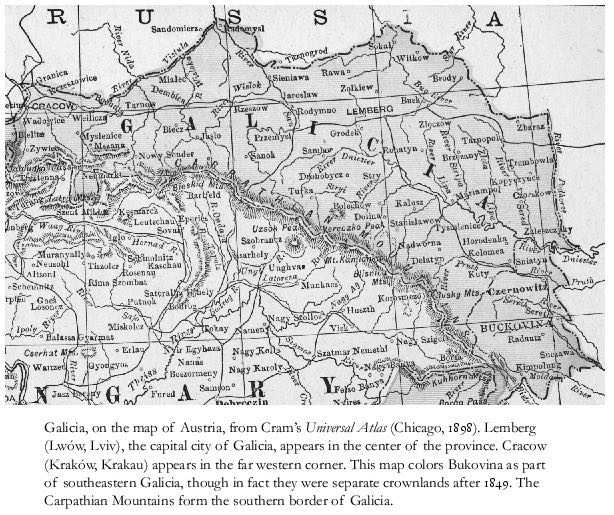
‘ The Land of Impossibilities ’
Wolf traces the complex justifications and enthusiasms that fed into the
evolution of Galicia as a defined section of the Habsburg lands. His close
examination of the cultural life of Galician cities : newspaper reports
of performances by Mozart’s son Franz Xaver in Lviv in 1817-8 , and
the memoirs of Aleksander Fredro, for whom, “ The domestic happiness
of the Pole is at present a flowering oasis in the Sahara desert. ” Except
that, as Wolff notes, in the political desert of Metternich’s Galicia, “ the
oasis was a mirage ”. Metternich was very happy to leave Galicia
after his brief visit. There was a fundamental contradiction in the Habsburg
administration Galicia, at once treating it as a foreign possession and
as an integral province of the empire, that never ultimately resolved itself
except in the person of Franz Joseph, who visited the province several
times during his long reign from 1848 to 1916. Wolff recounts several Franz-Joseph-Märchen or
Galician legends of the emperor and his special importance for Jews in
the province. The internal tensions in the province were the source of
revolt and massacre in the political sphere and of a suprisingly rich literary
tradition that encompassed Leopold von Sacher-Masoch, homegrown decadents
of the 1890s such as Tadeusz “ Boy ≵ Zelenski, Isaac
Babel, Bruno Schulz, and others. Wolff’s account of The Wedding (1901)
by Stanislaw Wyspianski is the proclamation of a Galician (Polish) masterpiece
of modernist theater. The account of Bertha Pappenheim and her depiction
of the hunger-artist as emblematic of Galician Jews marks her as a feminist
literary precursor of Franz Kafka. This is a literary history of a mysterious
land.
“ Travelogue became allegory, because Galicia was not merely topographical terrain, but the philosophical domain of enlightened fantasy. ” The Idea of Galicia is also a beautifully written study of political aspirations, efficient bureaucracy, and ethnographic shifts. Wolff elicits how a distance grew between Polish and Ruthenian Galicians, and how the Ruthenian and Ukrainian destinies became entwined. And then came the war of 1914 to 1918, and in its aftermath Galicia “ vanished from the map of Europe . . . again evocative of loss and longing . . . homeland preserved only in memory. ”
‘ a realm of indeterminate existence ’
The Idea of Galicia seemed at first to read like a
gloss on aspects of The Adventures of Doctor Eszterhazy ,
Avram Davidson’s stories of a small and polyglot and marginal empire
in the shadow of Austria-Hungary, or his curious tales of immigrants
in America (“ The Slovo Stove ”). The photograph
of the emperor Franz Joseph astride his horse in Galicia in 1903
could be Ignats Louis calming the population of Bella in “ Cornet
Eszterhazy ” ; and surely “ The King’s
Shadow Has No Limits ” is firmly in the tradition of the Franz-Joseph-Märchen .
And yet this the notion of a gloss did not sit right, for Davidson
was not an imitative or derivative writer, and so I kept thinking
about it until I recognized that his central European tales evolved
fully formed and parallel to the historical Galicia. See “ The
Inchoation of Eszterhazy ”. Eileen Gunn records the biographical
sources for this in her biographical essay “ Water from
a Deep Well ” (in Everybody Has Somebody in Heaven ).
While Davidson’s father’s family came from the Baltic
cities of Riga and Memel, his mother, née Lillian Adler, “ came
from a large family of Hungarian Jews. Avram and his younger sister
Rhoda grew up in an extended family of Yonkers aunts and uncles and
cousins. ” “ I had aunts, ” Davidson
wrote. “ Boy did I have aunts. ” The stories
of family and the old country that he heard as a child, and a lifetime
of reading “ omnivorously ” enabled him to
create a richly populated, very picturesque, and folkloric land that
so closely resembles aspects of the historical Galiciaand yet is
utterly distinct from it. Does he fit within a Galician tradition ?
Probably not, but anyone who appreciates Davidson’s central
Europe will find this book to be a source of interest and pleasure.
PAPERBACK IN DRAG
And now I must move on to a topic that pains me deeply. The copy of The
Idea of Galicia that I obtained is what the late Reno W. Odlin
called a PAPERBACK IN DRAG : a book object glued into a glossy hardcover
case. My copy is a print on demand object, the text stock with the feel of
a photocopy on mediocre office paper, and the images murky as a photocopy
of a photocopy (the map above, from the online form of the introduction [here]
has a luminosity and contrast lacking from the printed book). These production
values commit violence upon the scholarship and wit contained in this book.
Inquiries to the Stanford University Press production department indicate
that the initial print run comprised 500 casebound copies and 200 softcover
copies ; when these were exhausted, the book was turned over to print
on demand fulfilment for their distributor (University of Chicago). I have
not seen the original printing and would be curious to learn if a better
grade of paper was used.
The Idea of Galicia is fascinating book, and a notable one ; I chose to read it as a book on paper, but you might wish to consider reading it as an e-book. This is the first time I have ever written such a suggestion. I fear it will not be the last.
On reading other writers
“ You don’t read them to copy what they did, but you read them to see what they did. ”
Dorothy B. Hughes
[cited in the afterword to the re-issue of her 1943 novel The Blackbirder .]
Black snowflake

— Michael Swanwick. It Came upon a Midnight. Three Brief Midwinter Tales . Edition of 100 copies, signed by the author on the title page. [Philadelphia : Dragonstairs Press, 2011]. Snowflake Bentley *, move over ! Michael Swanwick’s tale “ Snowflake People ” is a profound twenty-first century contemplation of the form and function of the snowflake, as lovely a glimpse of impermanence as any of Wilson Bentley’s superb photographs (and the other two stories are pretty dandy, too).
* Snowflake Bentley by Jacqueline Briggs Martin, illustrated by Mary Azarian (Houghton Mifflin, 1998)
Recent reading
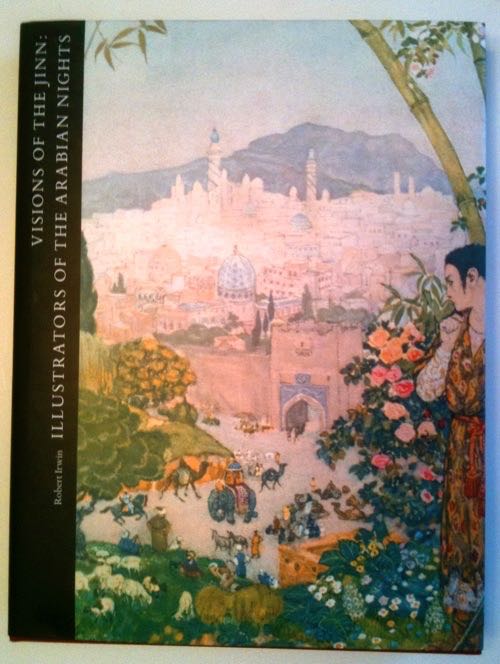
— Robert Irwin. Visions of the Jinn : Illustrators of the Arabian Nights. The Arcadian Library in association with Oxford University Press, [2011]. Studies in the Arcadian Library No. 7. Full page color illustrations throughout. 256 pp. Lush oversize history of the visual aspects of the Arabian Nights in western culture, with particular emphasis on the editions published in the nineteenth and early twentieth centuries. Irwin is a deft interpreter of the illustrators and the context of their work, both in the tradition of the illustrated book and as artists interpreting the exotic material of the Nights. A visual analogue of his essential The Arabian Nights : A Companion (1994), Visions of the Jinn gives a clear account of how the market for illustrated selections of stories guided the migration of the Arabian Nights into the domain of children’s literature : the strong erotic elements disappeared from the text and then from the artwork.
— — — —

— Brendan Byrne. The Showing of the Instruments. A Novella . 55 pp. Phone Booth Press, [2011]. Stitched, hand bound in pictorial covers. Fearsome little pamphlet recounting incidents of life and death in New York City. Smart and abrasive. A first book, I think.
— Mike Ashley. Out of This World. Science Fiction : but not as you know it . British Library, 2011. Companion to the exhibition at the British Library earlier this year. For a review in The New York Review of Science Fiction (forthcoming).
— Dorothy B. Hughes, The Blackbirder . Afterword by Amy Villarejo. (1943 ; Feminist Press paperback, [2004]). Hard-boiled novel of suspicion and life on the run in wartime America.
— Vincent McCaffrey. A Slepynge Hound to Wake. A Mystery. Small Beer Press, [2011]. Bibliomystery set in Boston, told in the engaging narrative voice of bookseller Henry Sullivan, whose place in the ecology of the book trade is somewhere between book scout and modest private dealer. The Hound, as Sullivan describes himself, is a useful addition to an ongoing Taxonomy of the Book Trade that encompasses the Ant and the Grasshopper, the Giant Raptor, the Knitter, the Barker, and the Twitcher. McCaffrey is proprietor of the famed Avenue Victor Hugo Bookshop (once a Boston landmark) and he writes movingly of the allure of books. The tone is decidedly elegiac in the many reflections upon the Demise of the Book Trade ; the heart of the book is in the rich detail of Sullivan’s friendships and daily interactions.
— Patricia Meyer Spacks. On Rereading . The Belknap Press of the Harvard University Press, 2011. Re-reading is an interesting topic and a perennial concern of the Endless Bookshelf. On Rereading records the reflections of the author, a professor of English, emerita, of the University of Virginia, upon re-reading children’s classics, favorite novels ( Pride and Prejudice and Middlemarch ), representative novels of the 1950s, 190s, and 1970s, as well as re-reading Arnold Bennett’s The Old Wives’ Tale , Wodehouse, and, rather surprisingly, Islandia by Austin Tappan Wright. There are some acute observations about individual texts and aspects of reading and re-reading — “ reading with others can obscure as well as reveal truths about the text considered and about the nature of a personal response. Group opinion may have distorting force. ” Generally I found it heavy going. The following passage, however, is exemplary : “ Rereading is exploring new ground — new ground in familiar territory. By the criterion of pleasure, it ranks high, and its evocation of fresh meanings gives it weight as a source of instruction. ”
Your correspondent has a fundamental disagreement about the author’s recurring metaphor : “ the experience of rereading creates a palimpset of consciousness. A manuscript that has been written on over and over, retaining traces of each earlier stage ; that’s what our minds become in relation to Emma . . . ” . At the root is a basic misunderstanding of the word, for a palimpsest is by definition a manuscript rubbed smooth again (even if earlier texts are sometimes discernible) : in any case, NOT a working description of how this reader approaches a familiar text.
It is well to remember Hazlitt and “ the pure, silent air of immortality. ”
— — — —
— Michael Flynn. Eifelheim. Tor paperback, [2006]. Excellent first-contact novel, extraterrestrials who made a forced landing in a forest in Germany in 1348, neatly tied into a more or less contemporary frame story.
— Henning Mankell. The Troubled Man . Translated from the Swedish by Laurie Thompson. Alfred A. Knopf, 2011. Heavy going. Reader, I tried (and persevered to the end). The Remorseful Day , Colin Dexter’s conclusion to his series of Inspector Morse novels was cheery morbid fun by comparison.
— Donna Leon. Acqua Alta . (1996 ; Penguin/Grove Press paperback, 2009). Art theft, opera, and murder during the winter flood season in Venice.
— Maureen F. McHugh. After the Apocalypse. Stories . Small Beer Press paperback, [2011]. McHugh keeps close, unsettling scrutiny on the human aspects of pandemic, or a zombie invasion combined with a temporary breakdown of the legal system, or the “ apocalypse ” ; and in “ Kingdom of the Blind ” she has written the most perfect deadpan rejection of the Singularity that I have ever read : ̉ I’m pretty sure I’ve got proof that our system is aware. Like the ones in the article. And they’re going to shut it down. ” Her grasp of narrative tone is impeccable.
Nested Scrolls by Rudy Rucker
I have put up a file of my review of Rudy Rucker’s autobiography, Nested Scrolls , for The New York Review of Science Fiction (August 2011), here : “ Authors, like fractal patterns, demonstrate recurring similarities at macro- and micro-levels: the closer the focus, the more complex and intrinsically themselves they appear. ”
Bookshelves
— Unpacking My Library : Writers and Their Books. Edited by Leah Price. Illustrated [vi], 201 pp. Oblong format (5-1/2 x 8-1/2 inches). Yale University Press, [2011]. Thoughtful introductory essay on the significance of the bookshelf, of book ownership, and of reading in a digital age, followed by short interviews with thirteen contemporary writers and pictures of their bookshelves. The authors are Alison Bechdel, Stephen Carter, Junot Díaz, Rebecca Goldstein & Steven Pinker, Lev Grossman & Sophie Gee, Jonathan Lethem, Claire Messud & James Wood, Philip Pullman, Gary Shteyngart, and Edmund White. The observant reader will recognize a strong showing by the literature of the fantastic from these names as well as from the photographs of their bookshelves. The best paragraph appears in the interview with Gary Shteyngart :
Yes, I’m big on sniffing books. The old Soviet ones really have this strong smell reminding me, for some reason, of tomato soup in a cheap Soviet cafeteria.
Each of the authors has chosen a top ten list of books, and these are presented opposite a montage of tiny pictures of the covers of the books. Some of the writers specifically discuss why they chose titles for this list but only author and title are recorded (clues to the edition can sometimes be deduced from the photograph). Jonathan Lethem remarks, “ The author’s secret books, the oeuvre behind the oeuvre. I’m obviously dedicated to things that are out of print, left-field, dubious. ” The two Charles Willeford titles on his top ten list are very advanced : Cockfighter (1962 ; the 1972 hardcover is shown) and A Guide for the Undehemorrhoided (1977). Alison Bechdel has drawn her choices (a quirky and characteristic approach ; note that her list comprises eleven books), reproduced below (click for enlargement) :
This glossy little oblong book, manufactured in China, seems to have been printed on paper folded against the grain as the copy sent for review has already started to curl ; the montages of little pictures (barely the size of postage stamps) are another sure sign that the design of the book was accomplished on a screen rather than with the intention of a physical book. There’s nothing wrong with a little bibliographical rigor in a book about books ; a full citation (to enrich the interview) would have recorded that Aldus Manutius was the printer of Lev Grossman’s Cicero, not the author. Interesting concept, with roots in an art installation by Buzz Spector in 1994 ; Yale published a predecessor volume on the libraries of contemporary architects (not seen). This iteration has some fun pictures of bookshelves and wide-ranging responses to the interviewer’s questions but somehow seems curiously lacking in substance, less than the sum of its parts.
Two Cases of Bibliomania
“ A Mild Case of Bibliomania ” : Ray Russell of Tartarus Press talks about his books :
http://www.youtube.com/watch?v=7h7-aIZRhhs&NR=1
“ the only way to get the books ” : Interview with book collector & author Mark L. Valentine (an education and a reading list) :
Secrets from the Attic
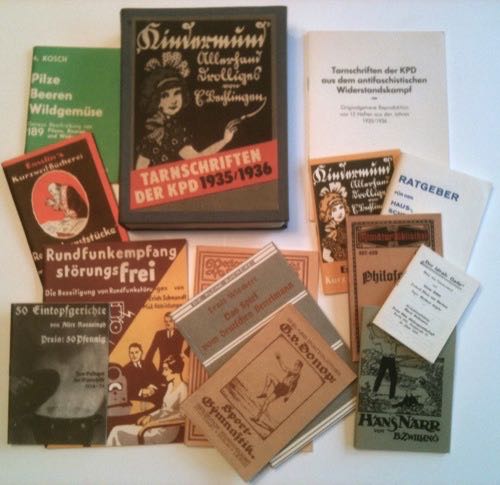
— Tarnschriften der KPD aus dem antifaschistischen Widerstandskampf. Originalgetreue Reproduktion von 12 Heften aus den Jahren 1935/1936 . Eingeleitet und zusammengestellt von Gerhard Nitzsche und Margot Pikarski. K. G Saur Verlag, [Dietz Verlag, Berlin, 1986].
These Tarnschiften are camouflaged publications with innocuous covers and false title pages concealing banned Communist texts and reports of the meeting of the exiled German Communist Party (KPD) in Moscow in 1935. The books and pamphlets were smuggled into Nazi Germany, where the police attempted to prevent their distribution. Totalitarian governments understand the power of the book and of words. These are facsimiles produced in another universe, when the DDR was still a functioning world. The Tarnhelm is the secret helmet of invisibility and other powers in the Nibelungenlied .
23 November 2011
Newly published
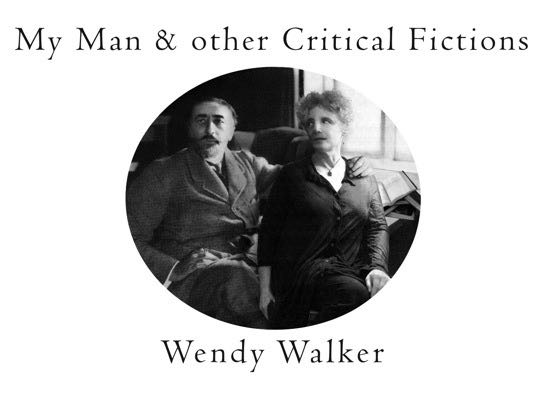
At the Grolier Club in New York City, a smart audience of about forty people gathered on 25 October to celebrate publication of the new book by Wendy Walker, My Man and other Critical Fictions . What is Critical Fiction ? was the prime question for the Critical Fiction Symposium convened that evening. Its members included the author, John Crowley, Jennifer Nelson, Ron Janssen, and your correspondent. The book is lovely, the conversation was wide-ranging (and can be heard here), and a good time was had by all. The hand bound issue for subscribers is also ready :
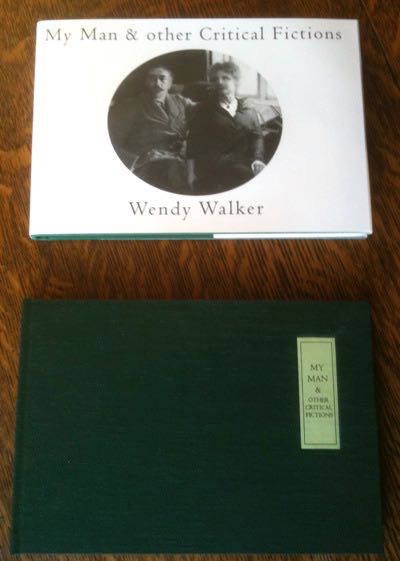
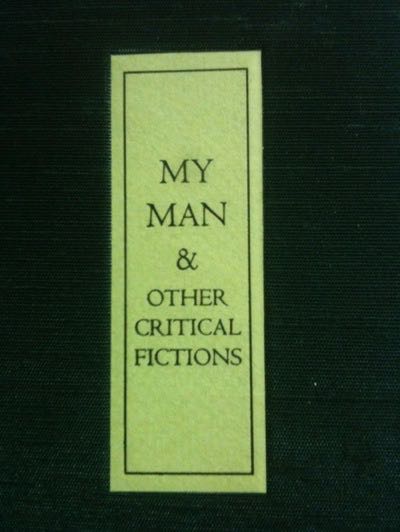
detail of upper cover (Asahi book cloth, printed label)

detail of marbled endpapers
The Social Fabric of America

[Cover design for a small midnight project, in press]
Current reading :
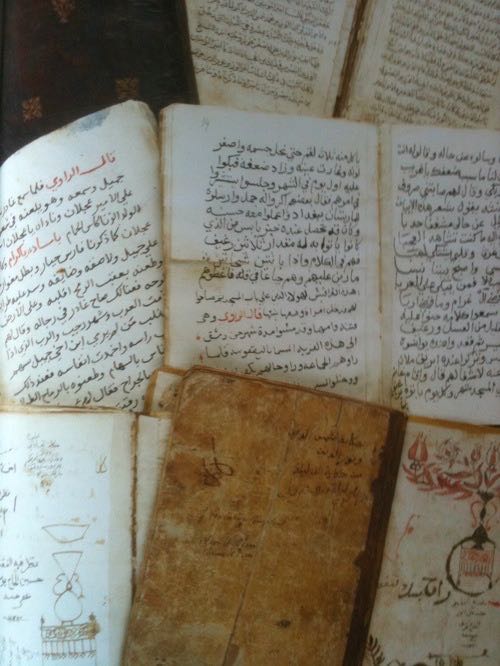
— Alastair Hamilton. The Arcadian Library. Western Appreciation of Arab and Islamic Civilization . Studies in the Arcadian Library No. 8. Full-page color illustrations, many folding, and color illustrations throughout. 408 pp. The Arcadian Library in Association with Oxford University Press, 2011.

Massive, lavishly illustrated and beautifully designed narrative survey of the western study of the Arab and Islamic lands and cultures, and discussion of manuscript materials from the Islamic world. The texts and examples are drawn from a vast private library in London, and many of the specific copies described are notable for their provenance or condition or scarcity. Pp. 361 to 398 comprise a “ Bibliography ”, a short title listing of portions of the library’s holdings. Hamilton enumerates the key works in his chapters on Travel (in eleven sub-headings from pilgrims to soldiers to women), Turcica, Science and Medicine, Islam and Christianity, Spain, and Oriental Scholarship and Literature. This is a most wonderful book to browse in, and for anyone with the slightest interest in books or the history of scholarship, it is irresistible. There is one further observation, however. Because so many of the volumes in the Arcadian Library are unique or impossibly rare, a book such as this, even when the scholarly apparatus is substantial and interesting (particularly for the way in which Hamilton makes connections across the boundaries of his subject divisions), is perilously close to becoming part of the genre that Bernard McTigue identified in a review * for the Bulletin of Bibliography of one of the volumes on the holdings of the Wormsley Library : biblio-pornography ; that is, sumputously illustrated catalogues of the unattainable.
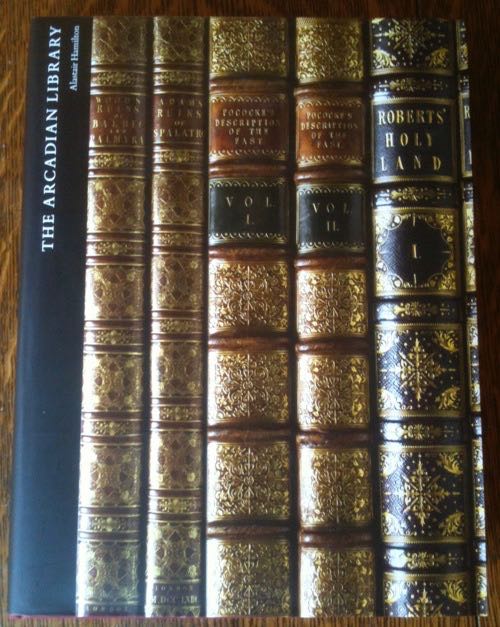
* - The Wormsley Library (1999) “ is a splendid example of a genre that might best be described as ‘ biblio-pornography ’. This is not to say that its subject is erotic in nature but rather that those who love books in their many manifestations will find much here to give them pleasure (probably not erotic) among the treasures that Sir Paul has assembled. ” — Bernard McTigue, Bulletin of Bibliography 57:2 (2000), pp. 185-6. This is the earliest, very precise use of the term that I have seen.
— — — —
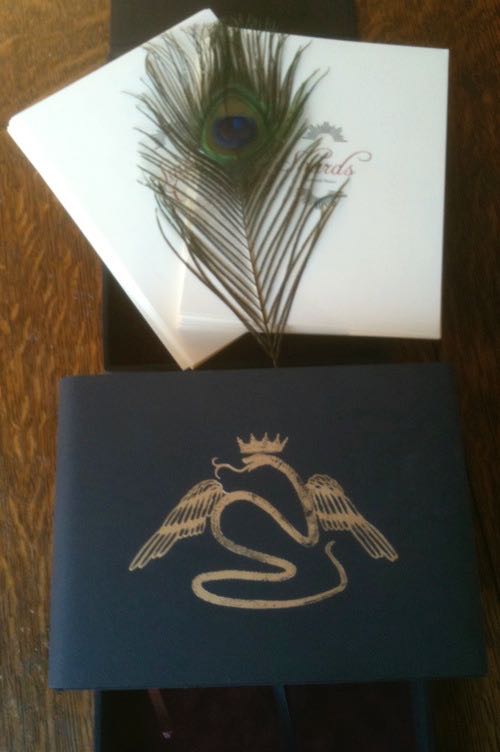
— Mark L. Valentine. The Peacock Escritoire [issued with:] Shards. Journal Notes [and:] Santiago Caruso. Portfolio. Bucharest - Orient : Passport Levant, 2011. With frontispiece, “ A Heathen God ” by Santiago Caruso. 236 pp., [1] f. blank, [1] f. colophon ; bound in black cloth, upper cover stamped in gilt, red endsheets, black dust jacket (spine titled in gilt, upper panel with heraldic design). Shards : [35] ff., loose letterpress sheets, variously paginated. Portfolio : title leaf, 12 plates (3 folding), most titled on verso. Issued in a folding box of black cloth stamped in blind, together with a peacock feather.
Exotic stories in a beautiful tome from Bucharest.
“ thinking, not of what the image might mean for her, but of how others might seek for it — even though only a few ever did ” — “ Morpheus House ”
I thoroughly enjoyed “ Morpheus House ” for its measured progress and sudden, kinetic ending ; “ Sime in Samarkand ” is brilliant, a critical fiction of Flecker and Sime, and really creepy ; and “ The Old Light ” is as charming and complex a reflection upon storytelling and reading as any, with a resonant concluding query.
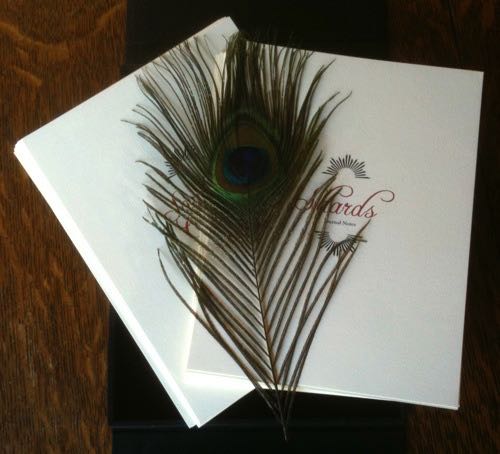
Recent reading :

— James Walsh. The Ephemera. Edition of thirty copies printed by the artist, October 2011. [20] pp., printed rectos only on a continuous sheet of Hahnemuhle Biblio, fan folded, in a printed wrapper of blue grey watercolor paper. A wonderful found poem on impermanence, a selection from Wm. Bartram’s Travels (1791), in conjunction with an installation of the text onto the walls of the gallery, at the Observatory, Proteus Gowanus Gallery, through 31 December 2011.
— Will Hermes. Love Goes to Buildings on Fire. Five Years in New York That Changed Music Forever . Faber & Faber, 2011.
— Dorothy L. Sayers. The Five Red Herrings. Gollancz, 1931. Lord Peter Wimsey among the artists in Galloway.
— Jean-Paul Kauffmann. Voyage to Desolation Island . Translated by Patricia Clancy. Harvill, 2001.
“ Although France officially has authority over this territory, it is actually the wind that controls the [Kerguélen] archipelago ”
If I had read Kauffmann when it appeared in French (1993), I could never have written “ The Polynesian History of the Kerguélen Islands ”, etc. When I wrote those stories (1993-4), I knew nothing of the Islands ; my friend DM read the stories in Another green world and kindly sent me this book.
— — —
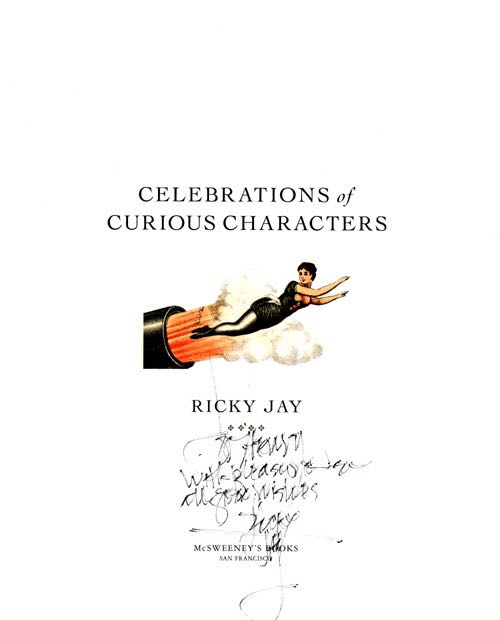
— Ricky Jay. Celebrations of Curious Characters . McSweeney’s Books, [2011]. Beautifully illustrated collection of short and quirky essays on unusual subjects. Originally written as radio talks, to read them is to hear the author’s voice and cadences.
— — —
— Sasha Chavchavadze. Museum of Matches. Proteotypes, 2011. Intriguing, richly illustrated, and gracefully written memoir that encompasses princely families of old Russia in exile, Cold War Washington society, the CIA, Cape Cod, and an artist’s pathways of discovery, with notable walk-on parts by Vladimir Nabokov and Edmund Wilson,
— — —
“ We had to misunderstand Language to learn it. ”
— China Miéville. Embassytown . Macmillan, 2011. A truly enjoyable, compelling book. Miéville is really good on interdependences (city/world/ecology or person/society or beings/communities) and on large activities accomplished through collective effort. I find the underlying principle of the novel’s intergalactic travel through “ immersion ” to be a direct descendant of Robert Sheckley’s story “ Specialist ”. Some lively play with language, linguistics, and academic mumbo-jumbo. The distinction between the the space-time fabric and ordinary existence, between “ immer ” and “ manchmal ” works more magically upon those who are not German speakers, perhaps. That is a trifle, since if for Burroughs, language was a virus, in this novel language is a drug. The payoff of the plot relies a bit much upon the Ariekans’ inability to acknowledge human vocal noise as evidence of intellect, but this is another trifle compared to how fully Miéville has earned the assertion that “ the girl who was hurt in darkness and ate what was given her ”, the narrator Avice Benner Cho, can make : “ I am a simile ”.
The first half of the book is fluid and personal to the narrator, and then there is a sudden shift to a summary or general mode at page 203. “ As they unfolded these times seemed pure chaos . . . ” was a phrase that made me think of the opening cadences of Ernst Jünger’s Auf die Marmorklippen . And yet the keys to the events of the second half are rooted in the personal. Avice remarks on page 75, “being a child is like nothing. It is only being. Later, when we think about it, we make it into Youth.” Which passage immediately came to mind when I encountered this : “ I don’t say they don’t remember ; I say that they can’t tell me how it was if they do. ”
— Charles Reade. The Cloister and the Hearth. A Tale of the Middle Ages (1861 ; Daily Express Publications, 1933). Originally published as a four-volume novel, I read it in a one-volume reprint.
“ Yet shall she not be photographed by me, but feebly indicated: for it was just four hundred years ago, the raillery was coarse, she returned every stroke in kind, and though a virtuous woman, said things without winking, which no decent man of our day would say even among men. ”
A rich and entertaining novel, equal parts the wanderings of a gormless young villager making his way from the Netherlands to Rome and the worries of a single mother whose skills as an herbalist led to accusations of witchcraft. The passage cited above makes explicit the constraints of writing a bawdy picaresque about late fifteenth-century Europe in language suitable for mid-Victorian society. The novel is rich in supporting characters, notably the Burgundian soldier Denys, and also full of the emergence of printing, with a walk-on role by the author of the Hypnerotomachia ; and on the last page the reader learns that the novel is a biography of the parents of Erasmus. The passage at the end of the fourth volume of the first edition, 1861 :
The very heavily theological parts dragged a bit. It would be interesting to learn if this was one of the texts that Cabell’s Jurgen turned upon its head by reviving bawdy innuendo ?
— Joseph Conrad. Victory. An Island Tale [1915 ; Everyman’s Library, 1998]. “ ‘ It’s perhaps in trouble that people get to know each other ’, she suggested. ” There is no art without crisis or incident producing change : it is a mistake to expect the characters to survive the devastating collision, but the reader does.
— Mike Ashley. Out of This World. Science Fiction : but not as you know it. British Library, 2011. Illustrated companion to the library’s exhibition, which reproduces some but by no means all of the material that was on view : Stapledon’s fantastic multi-colored timeline for the future was reason enough to buy the book.
The Laughable Game of What D’Ye Buy
The Laughable Game of What D’Ye Buy (Phila., 1850): Bookseller, Toyman, Milliner, Ironmonger — from Room 26
http://beineckeroom26.library.yale.edu/2011/10/31/the-laughable-game-of-what-dye-buy/
This creaking and constantly evolving website of the endless bookshelf : I expect that some entries will be brief, others will take the form of more elaborate essays, and eventually I will become adept at incorporating comments or interactivity. Right now you’ll have to send links to me, dear readers. [HWW]
electronym : wessells
at aol dot com
Copyright © 2007-2011
Henry
Wessells and individual contributors.
Produced by Temporary
Culture, P.O.B. 43072, Upper Montclair, NJ 07043 USA.



